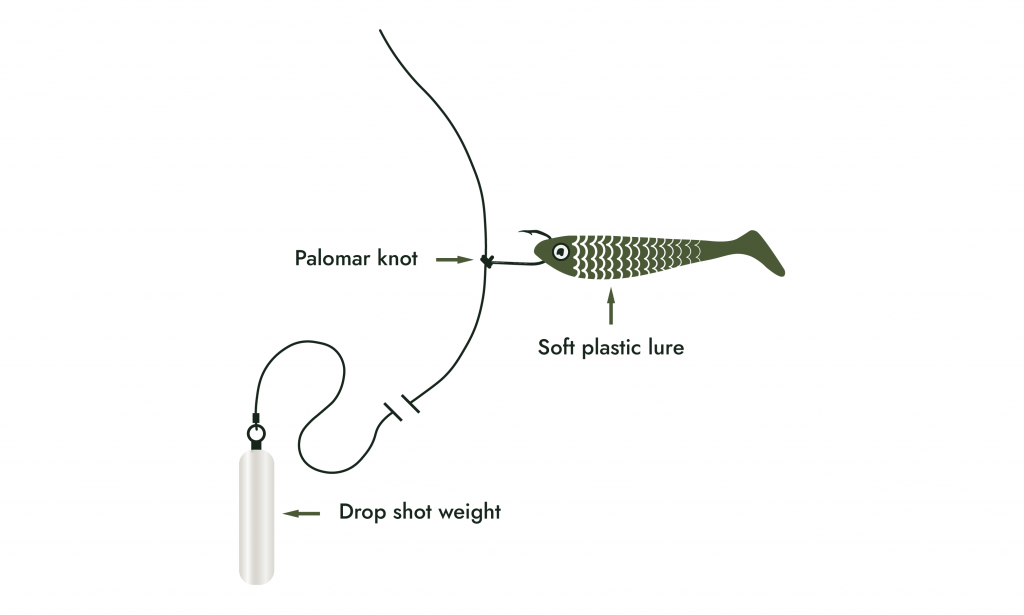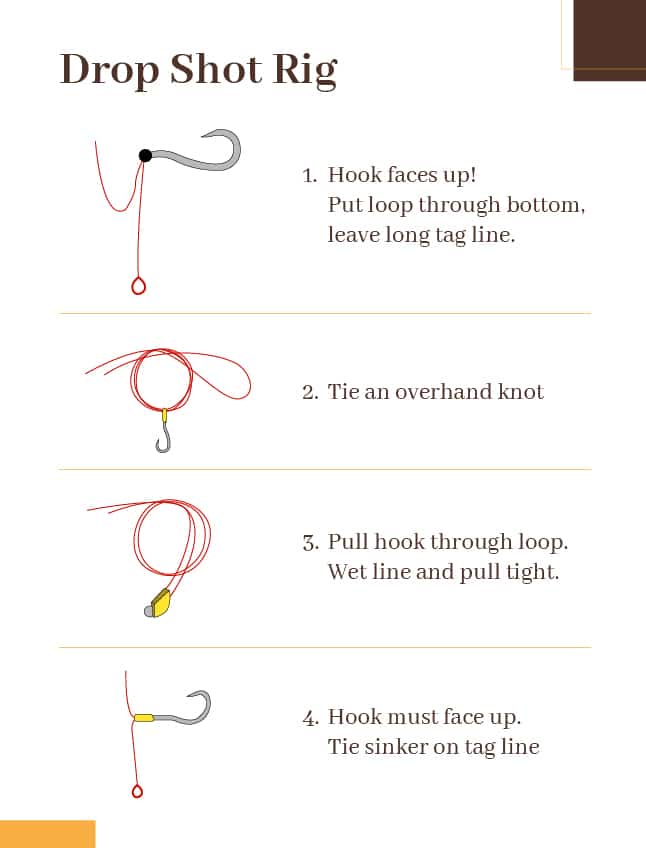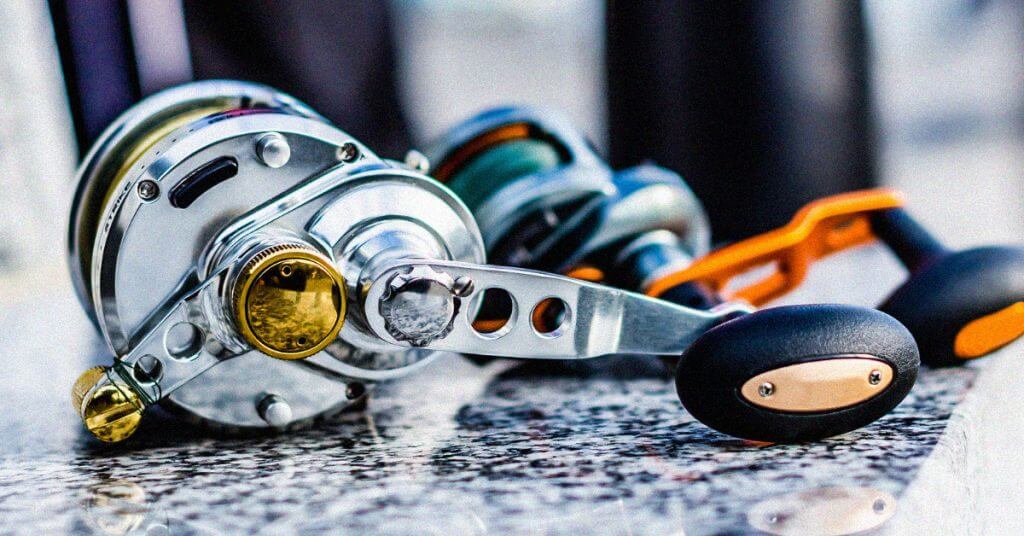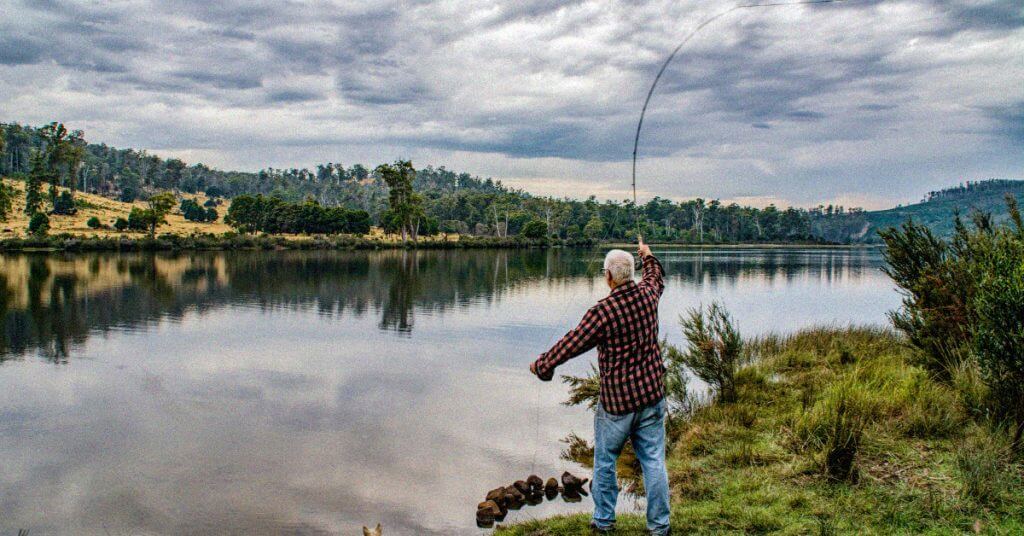Many anglers think that drop shotting is a complex technique reserved for pros, but they’re missing one simple truth.
I learned it in less than five minutes, and I’ll show you exactly how.
Last updated: January 24th, 2025
What is a Drop Shot

Here’s the #1 thing you should know about drop shotting – it’s way simpler than most anglers make it out to be.
A drop shot rig comes down to just three components:
- Your main line with a hook tied to the end
- A leader extending below the hook
- A weight at the bottom of that leader
Your setup will look exactly like the diagram above. That’s it. No fancy gear, no complicated knots.
Let’s move to the rigging process.
What You Need for Rigging a Drop Shot
When it comes to gear for drop shotting, you will likely not need to buy anything new. Most anglers already have the essential equipment in their collection.
Rods and Reels
For the best results, I suggest going with an extra fast action medium rod paired with a spinning reel.
In my opinion, this combination is perfect for drop shotting because it gives you two critical things: the sensitivity to detect those light bites and the power to handle larger bass when they strike.
Since this is a finesse technique, the right rod action matters.
As for the reel, your current freshwater spinning reel will probably work just fine – no need for any special purchases here.
Line
When you choose your line to tie a drop shot knot, you’ll want to go with the line that has the lowest visibility. I suggest a 6-pound test fluorocarbon line and leader.
Keep in mind that bass can be surprisingly skittish when you’re fishing finesse techniques like this.
They’ll inspect your bait closely before committing, and anything that looks suspicious will send them swimming away.
Drop Shot Hooks
Hook selection for drop shotting is straightforward – stick around a size 1- 1/0.
While you’ll find various hook styles on the market, a drop shot hook is your best choice. These hooks have a large circumference and provide the best action and natural presentation for your bait.
Drop Shot Sinkers
The weight you choose plays a key role in drop shotting because it keeps your bait suspended a few inches above the bottom – right in the strike zone.
For this setup, a crimped swivel weight that clips to the end of your line works best. You can also tie it on if you prefer.
For weight size, I don’t recommend going lighter than ⅜ ounce. On windy days with choppy water, I’ll bump up to a ¾ ounce to maintain better control.
I also recommend that you choose a weight that blends in with your surroundings. You don’t want fish nipping and playing with the weight at the bottom, so the more it blends in, the better.
Drop Shot Worms
When fishing a drop shot, you have a few choices for the type of bait, but I recommend using plastic worms or something in the same realm. You can use a rubber minnow as well if you prefer, but the presentation of a drop shot works really well if you stick to rubber worms.
One of my personal favorites is anything from Berkley Gulp! baits. Their scented products give you an extra edge, making them even more appealing to bass.
Since the rig itself handles the presentation, you just need to focus on matching what bass are feeding on in your local waters. Keep it simple and natural.
How to Rig a Drop Shot

Now that you’ve got everything you need, let’s walk through the process of rigging your drop shot.
1. Thread your line through the hook eye, leaving at least a foot of tag end for your leader.
2. Make a loop and pass it back through the bottom of the hook.
3. Hold the loop end and make a single palomar knot with the other end. Wet it and pull it tight. You’ll now have your hook secured about a foot above your tag end.
4. Rig your shad or worm (either wacky or Texas style), attach your weight to the tag end, and you’re ready to fish.
How to Fish a Drop Shot
Anglers.com writer Wesley Littlefield offers some insights for drop-shotting in this video.
Now comes the exciting part – putting your drop shot rig to work.
While some anglers think this technique is just about casting and out and letting the lure sink to the bottom, there’s actually much more to it. Drop shotting offers various strategies that can improve your success rate with bass.
Deadsticking
I find this to be one of the most effective drop shot techniques in my arsenal.
Here’s how it works: Let your weight hit the bottom and stay put for about 15 seconds. Then, slowly lift it up and let it fall back down for another 15-second pause. Keep repeating this pattern as you work the rig back to your position.
It’s not uncommon for many minutes to pass between casts, so you need to be patient.
In my experience, this method works best when you’ve located bass, since you’re not really covering much water.
Current Fishing
One of the things that I love about drop shotting is that it works great in heavy currents, where standard rigs often struggle to maintain a natural presentation. While other methods would need you to size up your lures (which isn’t ideal), a drop shot keeps things finesse.
For current fishing, choosing the right-sized weight is crucial. I recommend a ½ ounce weight – it’s heavy enough to ensure that your lure stays at the bottom of the lake or river.
The goal is to let the current do all the work for you. You need to find that sweet spot:
- Too heavy: your worm buries down into the mud
- Too light: both weight and worm move around too much, messing up presentation
- Just right: your worm wiggles naturally in the current while staying in the strike zone
Fishing Cover
As bass anglers, we already know that heavy cover in shallow water is prime bass territory. Hitting this spot with a drop shot is a sure-fire way to catch a lot of bass.
For this technique to work, you need to have a spinning rod and reel because it will help you get the perfect vertical drop.
The technique is straightforward: drag your weight along the bottom until you make contact with structure. When you hit something, give your line a few shakes to attract attention. If you don’t get a bite within a few seconds, reel in and try another spot.
I’ve found this method to work exceptionally well in shallow water with dense cover where bass love to ambush their prey.
Drag It
If you have no idea where the bass are but are still determined to catch some, then you’ll want to choose this method.
A lot of experts say that they won’t bite if you jig it around on the bottom, but they bite when you drag it. Maybe it’s because you’re creating a louder disturbance, but who knows.
Anyway, professional anglers use this drop shotting technique, so I would recommend giving it a try.
Pitch your bait and let it sink to the bottom. Once it hits bottom, simply retrieve it fast enough to drag the weight across the base of the water.
Final Thoughts
There’s no doubt that drop shotting provides a great strategy for the lake and ponds that are overfished. In my opinion, the best time to test out a drop shot is when you’re not having luck with anything else.
By this point, you should understand just about everything you could want to know about drop shotting for bass. Here are a few key points to remember.
- Choose the right size weight – too heavy or too light will mess up your presentation
- I recommend using Berkley Gulp! Worms rigged waggy style
- Make sure you understand how to rig your hook and weight
- Apply the same basic rules of fishing to this style
That’s about it, good luck!





Thanks for the info
That’s what we’re here for :)
Glad we could help, Shane!
Can a Drop Shot be rigged under a Slip Bobber Rig with success?